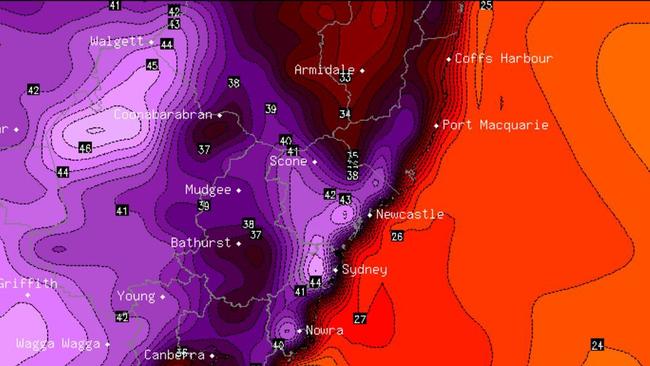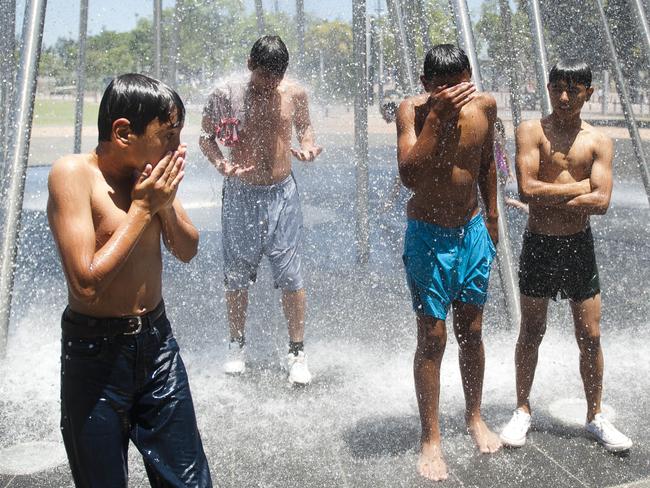Residents told to switch off appliances during crucial hours of peak demand
TIGHT conditions for electricity supply have eased , according to the energy regulator, after people were urged to ‘go to a movie’ instead of sit at home in the air con.

RESTRICTIONS on electrcity supply in New South Wales and the Australian Capital Territory have eased after a blackout during a major heatwave across the country.
The Australian Energy Market Operator (AEMO) confirmed “tight” conditions had subsided following a peak in demand. It said residential load shedding was not required in NSW but commeded the Tomago aluminium smelter for reducing their demand during the busy period.
“These efforts enabled the power system to provide uninterrupted electricity supply to the region,” AEMO said in a statement, reminding people to be mindful of consumption.
Earlier Energy Minister Don Harwin told people across NSW to go to the movies or head to the shops instead of turning on the television at home and cooking in a bid to save power during the Sydney heatwave.
Mr Harwin would not reveal which suburbs and areas would be targeted for load shedding if it was needed but said earlier there was more generating capacity avaialable.
“We’re actually in surplus now, we’ve got more generating capacity than demand being placed on the system right now,” he said.
“The less good news is that demand is slightly higher than we’d anticipated.”
On Friday 11,000 homes and businesses in Strathfield, Burwood, Croydon and Homebush were without power due for more than half an hour due to a fault at a major substation at Burwood.
Ausgrid tweeted the fault was not due to “load shedding”, instead downed wires were apparently responsible.
Earlier it confirmed crews were “on their way” to restore power to 900 homes in The Entrance, on NSW’s central coast.
Power out to about 11,000 customers in parts of #Strathfield, #Burwood, after a fault on local network, not load shedding. Crews are on way pic.twitter.com/55zXSjUdgB
— Ausgrid (@Ausgrid) February 10, 2017
Ausgrid on reports of possible blackouts in Sydney pic.twitter.com/ThZW2AgnKw
— Kylar Loussikian (@kloussikian) February 10, 2017
Power back to most customers in Strathfield & Burwood, crews working to reconnect 750 around Burwood Rd & Queen St, reports of wires down
— Ausgrid (@Ausgrid) February 10, 2017
Emergency crews on the way to safely restore power to about 900 customers in #TheEntranceNorth For updates see https://t.co/MxbaFPxBlK pic.twitter.com/b82HDfVd8T
— Ausgrid (@Ausgrid) February 10, 2017
Residents in NSW and the ACT were asked to switch off appliances between 3.30pm and 6pm Friday to avoid rolling blackouts across the state.
As residents suffer through a heatwave, the state government has asked residents to run their airconditioners no lower than 26C, as authorities are warning extra power use could lead to load shedding.
The Australian Energy Market Operator (AEMO) expected demand for electricity to be at its highest in six years this afternoon, leaving the state at risk of rotational outages.
NSW Energy Minister Don Harwin asked residents to consider having dinner later and to switch off any electrical appliances that are on stand-by but not being used.
Mr Harwin there had been a good response to AEMO’s notice that the state needed more power, with extra capacity being added to the system.
“We are in surplus now,” Mr Harwin said about 3.30pm.
“We have more generating capacity than demand being placed on the system right now.”
He said some industrial users including Tomago Aluminium, and Visy paper mill had taken some of their operations offline to help conserve energy.
“We are grateful to their help. And there are others,” he said.
“I would appeal to other businesses who are able to reduce their business usage during the expected peak, between 4.30-6pm to do that as soon as they possibly can.”
But he said demand was slightly higher than anticipated and so he hoped that residents would respond to calls for them to conserve energy as much as possible.
“If, for example, people rather than going straight home and turning on the television and cooking, want to consider going to a movie, going out to a shopping centre, keeping the load low, every bit like that helps,” he said.
He also refused to reveal which suburbs could be in line for forced blackouts.
Earlier the NSW opposition questioned why only half the Liddell Power Station was operating as soaring temperatures put pressure on the state’s energy supplies.
Labor leader Luke Foley says two of the coal-fired power station’s units aren’t operating on Friday and he’s demanded an explanation from the Berejiklian government.
“We’ve got the energy minister out there now on radio telling people to turn off their air conditioners, to turn up the temperature in their refrigerators, just to keep the lights on,” Mr Foley told reporters.
“What he hasn’t told us is that only two of the four units at the Liddell Power Station are operational.”
AAP understands the two units at Liddell are closed for maintenance.
Here’s what you need to know about the potential blackouts.
WHAT IS LOAD SHEDDING?
Also known as rolling blackouts or rotational outages, load shedding occurs when authorities deliberately turn off power to certain areas for short periods of time to stop the system from overheating.
It means that small groups of residents may lose power for short periods of time, to reduce the amount of power being used and stop the entire system from going down.
The idea is for the lights to go out for about half an hour in one suburb, before the blackout is rotated to another area, so that one street or community does not lose power for long periods.
Certain critical infrastructure is exempted from load shedding including hospitals, prisons and large meeting places.
About 90,000 South Australians experienced load shedding on Wednesday night at the end of a 42C day.
AEMO will make the decision on whether to start load shedding, and will then inform the operator of the NSW transmission network TransGrid to tell electricity providers Essential, Endeavour and Ausgrid to shut off power.
In South Australia, the government decides ahead of time what suburbs are chosen for the blackouts, and it has even released the list showing the order that suburbs would be impacted.
But the situation in NSW is different, with the energy providers dediding where the cuts will be.
An Ausgrid spokesman told 9news.com.au that the locations would not be revealed to the public until they occured.

WHY IS IT HAPPENING?
The AEMO has put out a notice saying it believes NSW won’t have access to enough power to meet demand this afternoon.
The state is in the grip of a heatwave, with Sydney’s CBD expected to reach 38C today, and western Sydney expected to get to reach 44C.
A TransGrid spokesman said having several hot days in a row could lead to higher electricity use as people were more likely to turn on airconditioners. People are also more likely to use more power on weekdays than weekends, when they can do other things like go to the beach or head to shopping centres to keep cool.
An AEMO spokesman told news.com.au that peak demand for Friday afternoon was forecast to hit 14,000 megawatts, close the record peak demand in NSW of 14,744 megawatts, which was set in 2011.
Energy demand rising in parts of Sydney, C Coast & Hunter as temps soar - tracking on par with record peak day on Ausgrid network in 2011 pic.twitter.com/izVI0QiL4v
— Ausgrid (@Ausgrid) February 10, 2017
ARE RENEWABLES TO BLAME?
Unlike South Australia, which no longer has coal-fired power, NSW still gets 57 per cent of its electricity from coal.
“This scenario isn’t due to where the generation is coming from, the amount of supply needed has heightened demand, based on the weather,” the spokesman said.
According to AEMO figures from January, power from wind or solar made up just 11 per cent of the power entering the system. Hydro adds 15 per cent and gas adds 12 per cent.
By releasing the notice, AEMO is hoping electricity generators will produce more power to meet demand, and is also hoping residents will help out by reducing their electricity use. This may help to avoid load shedding.
While federal politicians have been quick to blame South Australia’s recent spate of blackouts on its high reliance on renewables, the state government has blamed AEMO’s management of the electricity grid.
WHAT YOU SHOULD DO
NSW Energy Minister Don Harwin is encouraging residents to save energy between 3.30pm and 5.30pm by:
● Turning the aircon up to 26C
● Try to leave cooking until later in the evening
● Adjusting fridge temperatures
● Switching off unused electrical appliances
● Turning off lights where it is safe to do so.
“The NSW government is doing everything we can to ensure a power outage is avoided but we encourage the community to reduce their energy use where possible,” Mr Harwin said.
AUSTRALIA SWELTERS
New South Wales, ACT, South Australia, Queensland and parts of Victoria are currently in the grips of a heatwave with cooler weather not in sight until at least Sunday.
Queenslanders will have to wait even longer for a respite with cooler conditions not expected until next week.
People living in northern Victoria are also working up a sweat before a cool change sweeps through the state, bringing much-needed relief on Sunday.
Canberra is also going to be hot with 41C today and tomorrow and 31C on Sunday.
“The Bureau of Meteorology has forecast two days of 41 degrees Celsius in Canberra so we may break the all-time record for the city’s hottest day,” Dr Liz Hanna, a climate and health expert at The Australian National University told news.com.au.
“The current record is 42.2 degrees Celsius set in 1968.”
— with AAP



